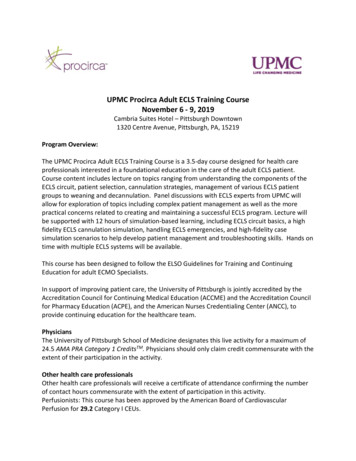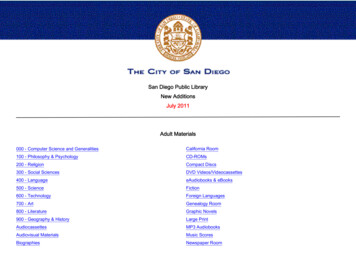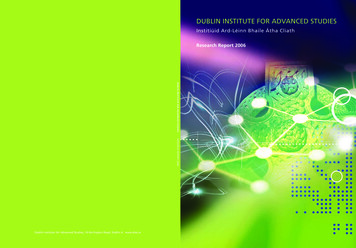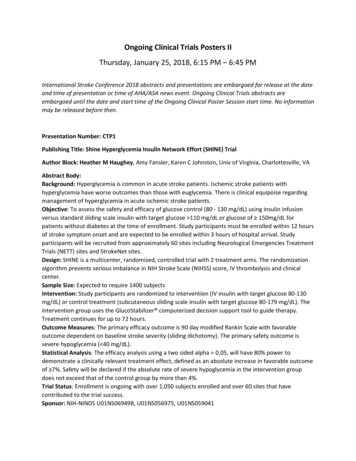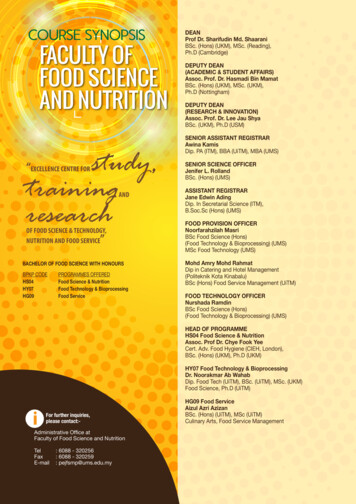
Transcription
COURSE SYNOPSISFACULTY OFFOOD SCIENCEAND NUTRITIONstudy,trainingresearch“EXCELLENCE CENTRE FORANDOF FOOD SCIENCE & TECHNOLOGY,NUTRITION AND FOOD SERVICE”BACHELOR OF FOOD SCIENCE WITH HONOURSBPKP CODEHS04HY07HG09PROGRAMMES OFFEREDFood Science & NutritionFood Technology & BioprocessingFood ServiceDEANProf Dr. Sharifudin Md. ShaaraniBSc. (Hons) (UKM), MSc. (Reading),Ph.D (Cambridge)DEPUTY DEAN(ACADEMIC & STUDENT AFFAIRS)Assoc. Prof. Dr. Hasmadi Bin MamatBSc. (Hons) (UKM), MSc. (UKM),Ph.D (Nottingham)DEPUTY DEAN(RESEARCH & INNOVATION)Assoc. Prof. Dr. Lee Jau ShyaBSc. (UKM), Ph.D (USM)SENIOR ASSISTANT REGISTRARAwina KamisDip. PA (ITM), BBA (UiTM), MBA (UMS)SENIOR SCIENCE OFFICERJenifer L. RollandBSc. (Hons) (UMS)ASSISTANT REGISTRARJane Edwin AdingDip. In Secretarial Science (ITM),B.Soc.Sc (Hons) (UMS)FOOD PROVISION OFFICERNoorfarahzilah MasriBSc Food Science (Hons)(Food Technology & Bioprocessing) (UMS)MSc Food Technology (UMS)Mohd Amry Mohd RahmatDip in Catering and Hotel Management(Politeknik Kota Kinabalu)BSc (Hons) Food Service Management (UiTM)FOOD TECHNOLOGY OFFICERNurshada RamdinBSc Food Science (Hons)(Food Technology & Bioprocessing) (UMS)HEAD OF PROGRAMMEHS04 Food Science & NutritionAssoc. Prof Dr. Chye Fook YeeCert. Adv. Food Hygiene (CIEH, London),BSc. (Hons) (UKM), Ph.D (UKM)HY07 Food Technology & BioprocessingDr. Noorakmar Ab WahabDip. Food Tech (UiTM), BSc. (UiTM), MSc. (UKM)Food Science, Ph.D (UiTM)iFor further inquiries,please contact:-Administrative Office atFaculty of Food Science and NutritionTelFaxE-mail: 6088 - 320256: 6088 - 320259: pejfsmp@ums.edu.myHG09 Food ServiceAizul Azri AzizanBSc. (Hons) (UiTM), MSc (UiTM)Culinary Arts, Food Service Management
Faculty of Food Science and Nutrition SYNOPSISPROGRAMME CORESCHOOL CORENT10102 FUNDAMENTALS FOOD SCIENCE AND NUTRITIONThe course will be focused on food requirement, function and source of nutrients in food, and quality and safety aspects offoods. The selected core subjects will be discussed in brief in other to give the students an overview on what is the field offood science/technology and nutrition all about.ReferencesBrown, J.E. 2014. Nutrition Now. 7th Edition. Australia: Wadsworth CENGAGE Learning.Campbell-Platt, G. 2009. Food Science and Technology. Singapore: Wiley-Blackwell.Murano, P.S. 2003. Understanding Food Science and Technology. Australia: Wadsworth CENGAGE Learning.Roday, S. 2007. Food Science & Nutrition. New Delhi: Oxford University Press.Smolin & Grosvener, 2010. Nutrition Science and Applications. 2nd Edition. USA: John Wiley & Sons, Inc.Thompson, J. & Manore, M. 2013. Nutrition for Life. Boston: Pearson.Williams, M.H. 2010. Nutrition for Health, Fitness, and Sport. 9th Edition. Boston: McGraw-Hill International Edition.NT10402 ANALYTICAL CHEMISTRYAnalytical chemistry is the branch of chemistry that deals with the measurement of chemical samples, both qualitative andquantitative. Analytical chemistry plays an important role in many aspects of chemistry, for example, medicinal,environmental, forensic, and manufacturing. In food, analytical chemistry finds many applications, for example, in theanalyses for the essential nutrients, chemical composition, level of deterioration or contamination, and authenticity.Undoubtedly, analytical chemistry forms an important part of the competency that food scientists and technologists oughtdevelop.ReferencesSkoog, D. A., West, D. M., Holler, F. J. and Crouch, S. R. 2014. Fundamentals of Analytical Chemistry. Ninth Edition. USA:Brooks/Cole, Cengage Learning.Christian, G. D., Dasgupta, P. K. and Schug, K. A. 2014. Analytical Chemistry. Seventh Edition. USA: John Wiley and Sons,Inc.Harris, D. C. 2010. Quantitative Chemical Analysis. Eighth Edition. USA: W. H. Freeman.Beran, J. A. 2011. Laboratory Manual for Principles of General Chemistry. Ninth Edition. United States of America: JohnWiley and Sons, Inc.NT10302 GENERAL PHYSICSA clear understanding of the basics of physics, i.e. the study of physical quantities, theories and calculations in translationaland rotational motions, types and concepts in energy. This course will expose some background on the behavior of fluids. Itwill also include sections in thermal physics as well as vibration and wave.ReferencesVuille, C., Serway, R.A. & Faughn, J.S. 2009. College Physics. 8th Edition. Brooks/Cole Cengage Learning, Canada.ISBN-10: 0-495-55498-7.Nicholas J. Giordano, 2010. College Physics: Reasoning and relationships. International student edition. Brooks/ColeCengage Learning, Canada. ISBN-13: 987-0-534-46244-4David Halliday, Robert Resnick & Jearl Walker, 2008. Fundamentals of Physics, 8th Edition. Wiley. ISBN:978-0-471-75801-3.Frederick J. Bueche & David A. Jerde, 2008. Principles of Physics. 9th Edition. McGraw Hill, US.NT10902 ORGANIC CHEMISTRYThis course discusses the basic definitions and concepts of organic chemistry that are required to understand and explainthe phenomena and the chemical reactions found in our daily life including the food systems. This includes the classification,nomenclature, structure and reactions of the major classes/groups of organic compounds. Emphasis is given to themechanisms of reactions. The importance and relevance of organic chemistry in both food and non-food applications, andbiological systems will also be discussed.ReferencesBruice, P. K. 2014. Organic Chemistry. 7th ed. United States of America: Pearson.Wade, L. G. (Jr). 2013. Organic Chemistry. 8th ed. United States of America: Pearson.Solomons, T. W. G., Fryhle, C. B. & Snyder, S. A. 2014. Organic Chemistry. 11th ed. United States of America: John Wiley& Sons.Carey, F. A. & Giuliano, R. M. 2013. Organic Chemistry. 9th ed. United States of America: McGraw-Hill.Klein, D. 2012. Organic Chemistry. United States of America: John Wiley & Sons.Smith, J. G. 2011. Organic Chemistry. 3rd ed. United States of America: McGraw-Hill.2
3Faculty of Food Science and Nutrition SYNOPSISNT11202 CALCULUSThis course provides a strong basic concepts and foundations in calculus. Thus, this course providing the necessarybackground knowledge for students. Student will be able to develop the ability to use analytic and graphic techniques tosolve problems involving calculus.ReferencesLarson, R. & Edwards, B.H. 2012. Calculus, 9th Edition. Singapore : Brooks/Cole Cengage LearningStewart, J. 2009. Calculus. 6th Ed: Brooks/Cole, Cengage Learning.Anton, H., Bivens, I. C. & Davis, S. 2010. Calculus : Late Transcendentals, 9th Edition. John Wiley & Sons (Asia) Pte LtdVerberg D., Purcell E. J. & Rigdon S. E. 2007. Calculus ninth edition. Pearson. United State of America.Smith R.T, Minton R.B. 2007.Calculus. McGraw-Hill: New York.Peter Kuhfitting. 2006. Technical Calculus with Analytic Geometry. Thomson: Australia.NT10802 BIOCHEMISTRYThis course discusses the important biomolecules and their chemistries in reactions that facilitate the processes in livingorganisms. This includes amino acids, proteins, enzymes, and carbohydrates. The structures, functions, mechanisms,kinetics and control of these components are discussed. The ATP energy generation and the electron transfer chain incarbohydrate metabolism involving the glycolysis, the citric acid cycle, and the oxidative phosphorylation processes are alsodiscussed.ReferencesCampbell, M. K. & Farrell, S. O. 2012. Biochemistry, 7th ed. United States of America: Brooks/Cole.Appling, D. R., Anthony-Cahill, S. J. & Mathews, C. K. 2016. Biochemistry – Concepts and Connections. Global Edition.Essex, United Kingdom: Pearson.Voet, D. & Voet, J. G. 2011. Biochemistry. 4th ed. United States of America: John Wiley & Sons.Garrett, R. H. & Grisham, C. M. 2013. Biochemistry. 5th ed. United States of America: Brooks/Cole.Moran, L. A., Horton, H. R., Scrimgeour, K. G. & Perry, M. D. 2012. Principles of Biochemistry. 5th ed. United States ofAmerica: Pearson.NT31103 SENSORY EVALUATION OF FOODSensory evaluation of foods is widely used in the field of food science and technology for food quality control, assurance andproduct development. It is the measuring of food attributes through a complex sensation that results from the interaction ofour senses such as taste, smell, touch and hearing when food is eaten. In addition, the concepts, principles and protocol ofwidely used sensory evaluation techniques will be explained. These include discriminative tests, descriptive tests, affectivetests and scaling methods. Data collection and statistical analysis will be discussed in order to obtain accurate and valid testresults.ReferencesAminah, Abdullah. 2000. Prinsip Penilaian Sensori, Bangi: UKM.Kemp, S. E., Hollowood, T. & Hort, J. 2009. Sensory Evaluation: A Practical Handbook. United Kingdom: Wiley-BlackwellLawless, H.T. & Heymann, H. 2010. Sensory Evaluation of Food: Principles and Practices. 2nd Ed. New York: Springer.Meilgaard, M., Civille, G.V. & Carr, B.T. 2007. Sensory Evaluation Techniques. 4th Ed. Boca Raton, Florida: CRC Press.NT10003 / NT21103 STATISTICSThis course discusses basic statistical concepts including parametric and non-parametric tests. The practical componentincludes demonstrations and tutorials on statistical analyses using software. The software used is SPSS, version 14, whichis one of the common statistical software used in academic research and industries. Students will be exposed to the use ofsyntax in statistical analyses.ReferencesArmitage P, Berry G, Matthews JNS. Statistical methods in medical research. 4th ed. Oxford. Blackwell Sciences. 2001.Coakes SJ & Steed L (2007). SPSS version 14.0 for Windows. Analysis without anguish. Australia: John Wiley & Sons. 274pages.Md. Idris Mohd . Noor (1995). Asas statistik dan penyelidikan perubatan. Kuala Lumpur: Dewan Bahasa dan Pustaka. 178pages.Swinscow TDV & Campbell (eds.) Statistics at square one. 10th ed. British Medical Association. 2002. Useful little“cookbook”,good for quick reference. Available online at: http: / / www.bmj.com / collections / statsbk / 160 pages.Ooi YBH (2007). Statistics for food, nutritional and health sciences. Including SPSS user guide with syntax for analyses.Lecture notes (pre-publication copy, limited circulation for registered students of SSMP only).
Faculty of Food Science and Nutrition SYNOPSISNT11002 CELL BIOLOGYThis course focused on cell types and its basic properties. Coverage will also include fundamental concepts such as thedynamic character of cellular organelles, the use of chemical energy in running cellular activities, cytoskeletons, replicationand expression of cell, cell cycle and intracellular signalling.ReferencesBolsover, S.R., Shephard, E.A., White, H.A. & Hyams, J.S. 2011. Cell Biology: A Short Course. 3rd Edition. New Jersey:Wiley-Blackwell.Contento, A. 2013. Laboratory Exercises and Techniques in Cellular Biology. United States of America: John Wiley & Sons,Inc.Hardin, J., Bertoni, G. & Kleinsmith, L.J. 2012. Becker’s World of the Cell. 8th Edition. Boston: Benjamin Cummings.Karp, G. 2014. Cell Biology. 7th Edition. Singapore: John Wiley & Sons, Inc.NT11003 CELL BIOLOGYThis course focused on cell types and its basic properties. Coverage will also include fundamental concepts such as thedynamic character of cellular organelles, the use of chemical energy in running cellular activities, cytoskeletons, replicationand expression of cell, cell cycle and intracellular signalling.ReferencesBolsover, S.R., Shephard, E.A., White, H.A. & Hyams, J.S. 2011. Cell Biology: A Short Course. 3nd Edition. New Jersey:Wiley-Blackwell.Contento, A. 2013. Laboratory Exercises and Techniques in Cellular Biology. United States of America: John Wiley & Sons,Inc.George, P. 2016. Principles of Cell Biology. 2nd Edition. Burlington: Jones & Barlett Learning.Hardin, J., Bertoni, G. & Kleinsmith, L.J. 2012. Becker’s World of the Cell. 8th Edition. Boston: Benjamin Cummings.Karp, G. 2014. Cell Biology. 7th Edition. Singapore: John Wiley & Sons, Inc.NT11203 / NT21303 PHYSICAL PROPERTIES OF FOODSA course discuss on those properties of foods that lend themselves to description and quantification by physical means. Itis an introduction course exposing students to various physical properties of food, including the thermal, surface, optical,mechanical (rheological), electrical and geometrical properties. The definitions, theory and principles, methods ofdetermination, as well as effects on food products are also discussed under relevant topics. This course also providesfundamental knowledge required in understanding advance courses, such as Unit Operation in Food Processing and FoodEngineering.ReferencesArana, I. 2012. Physical Properties of Foods: Novel Measurement Techniques and Applications (Contemporary FoodEngineering). Boca Raton: CRC Press.Bourne, M. 2002. Food Texture and Viscosity. Concept and Measurement. 2nd Edition. London: Academic Press.Figura, L.O. & Teixeira, A.A. 2007. Food Physics: Physical Properties – Measurement and Application. London: Springer.Karel, M. & Lund, D.B. 2003. Physical Principles of Food Preservation. 2nd Edition. New York: Taylor & Francis.MacDougall, D.B. 2002. Colour in Food: Improving Quality. Cambridge: Woodhead Pub.Sahin, S. & Gulum, S. 2006. Physical Properties of Foods. New York: Springer.NT20703 FOOD ANALYSIS & INSTRUMENTATIONThis course introduces students to the importance of food analysis as chemical compositions of foods are used to determinethe nutritive value, functional characteristics & acceptability of the food products. Students will be taught on preparation ofchemicals & instruments to conduct the analyses. Analytical errors including those arising from impurity of chemicals,instruments & methods used will also be discussed. Students will learn how to report their laboratory results, findings &calculations. Proximate analyses, as well as the theory & suitable methods to determine moisture, ash, protein, lipid,carbohydrate, mineral and vitamin contents will also be explained. Students will also be exposed to specific instrumentsincluding AAS, GC, HPLC, etc., to analyse specific or basic components that make up our major food components.ReferencesAOAC, 2000. American Official Analytical Chemists. 16th Edition. Washington D.C.: Association of Analytical Chemists.Christian, G.O. and O’rielly J.E. 1986. Instrumental Analysis. 2nd EditionKing, R.D. 1978. Development In Food Analysis Techniques - 1. Applied Science. LondonNielsen, S.S. 2003. Food Analysis. Third Edition. New York: Kluwer Academic / Plenum Publishers.Nitise wojo, P. 1996. Instrumentasi Dalam Analisis Makanan. Bangi: Penerbit UKM.Pomeranz,Y. 1994. Food Analysis: Theory and Practice. London: Chapman and Hall Publication.Suzzane, S. N. 2010. Food Analysis (Food Science Text Series). SpringerSuzzane, S. N. 2010. Food Analysis Laboratory Manual (Food Science Text Series). SpringerLeo, M.L.N. & Fidel, T. 2013. Food Analysis by HPLC. 3rd. Edi. CRC Press.Micheal, H.T. & Charles, L.O. 2014. Physical Methods in Food Analysis (Acs Symposium series). American Chemical Society.Leo, M.L.N. & Fidel, T . 2012. Handbook of Analysis of Active Compounds in Functional Foods. CRC Press4
5Faculty of Food Science and Nutrition SYNOPSISNT20903 FOOD CHEMISTRY AND BIOCHEMISTRYThis course covers introduction to the major food components such as water, carbohydrate, lipid, protein and other minorcomponents, namely vitamins and minerals. Students will be exposed to the chemistry aspect, classification, characteristicsand functional properties of each of the components. Fundamental knowledge of enzyme and food pigments will be taught.Basic biochemistry reactions and metabolisms relate to the major food components will also be discussed.ReferencesAkoh, C.C. & Min, D.B. (ed.) 2008. Food Lipids Chemistry, Nutrition, and Biotechnology. 3rd Ed. Boca Raton: CRC PressTaylor & Francis Group. [QP751.F647 2008]Belitz, H.-D., Grosch, W. & Schieberle, P. 2009. Food Chemistry. 4th revised and extended Ed. Garching: Springer. [TX 545.B3513 2009]Damodaran, S., Parkin, K.L. & Fennema, O.R. (ed.). 2008. Fennema’s Food Chemistry. 4th Ed. Boca Raton: CRC Press Taylor& Francis Group. [TX 541. F65 2008]McWilliams, M. 2005. Foods Experimental Perspectives. 5th Edition. Pearson Prentice Hall, New Jersey. [TX 531.M38]Simpson, B.K., Nollet, L.M.L, Toldra, F., Benjakul, S., Paliyath, G. & Hui, Y.H (ed.) 2012. Food Biochemistry and FoodProcessing. 2nd Ed. Wiley-Blackwell, USA.Vaclavik, V.A. & Christian, E.W. 2003. Essentials of Food Science. 2nd Edition Kluwer Academic/Plenum Publishers, NewYork. [TX 531.V33]Voet, D., Voet, J.G. & Pratt, C.W. 2008. Fundamentals of Biochemistry. John Wiley & Sons, New York. [QD 415.V63]NT20003 / NT30903 FOOD PROCESSING & PRESERVATIONThis course will discuss about the principles and techniques of food processing and preservation such as freezing,drying,heat treatment, and so on. Students are required to understand the advantages and disadvantages for each of thepreservation method. The effects of processing on food products (that affect the consumer acceptance) and the latesttechnology and development in food processing and preservation also being discussed.ReferencesBrown, Martyn (2008): Chilled Foods –A Comprehensive Guide (3rd Edition). Woodhead PublishingDennis R. Heldman, Richard W. Hartel (1998). Principles of Food Processing. An Aspen Publication. New York.Fellows, P.J. (2000). Food Processing Technology: Principles and Practice 2nd Edition. West Sussex: Ellis Horwood Limited.Hosahalli, R. & Michele M. (2006). Food processing: Principles and Applications. CRC Press.Norman N. Potter & Joseph H. Hotchkiss (1995). Food Science. Chapman and Hall.Russell, N.J. & Gould, G.W (2003). Food Preservatives 2nd Edition. New York: Kluwer Academic/Plenum Publisher.NT20203 FOOD MICROBIOLOGYThe course discusses basic principles of food microbiology, which include scope of study, classification of microorganisms,existing of micro flora in various foods and their source of contamination. Characteristic and factors affecting the growth ofmicroorganism that lead to either food spoilage or food poisoning are also discussed. An understanding to these factors ishelpful in designing methods to control or stimulate their growth. Students have the opportunity to learn a wide variety ofmicrobiological methods normally used in quality control and safety evaluation of foods. The control of microorganismsespecially food borne pathogens by various food preservation techniques and processing are also being highlighted. Apartfrom the detrimentally effects to food and human health, many of these microorganisms are used in the production of foodand food ingredients. A series of laboratory exercises are designed to provide student with the opportunity to develop skillsin the isolation, identification and enumeration of the major groups of microorganisms associated with food and foodproducts.ReferencesAdams M.R. & Moss, M.O. 2008. Food microbiology. 3rd Edition. Cambridge: Royal Society of Chemistry.Hogg, S. 2013. Essential microbiology. 2nd edition. New York: Wiley-Blackwell.Jay, J.M., Loessner, M.J and Golden, D.A. 2005. Modern food microbiology. 7th edition. New York: Aspen Publisher.Kornacki, J.L 2010. Principles of microbiological troubleshooting in industrial food processing environment. New York:SpringerNeelima Garg, K. L. Garg, and K. G. Mukerji. 2010. Laboratory manual for food microbiology. New Delhi: I.K InternationalPublishing House.Ray, B. and Bhunia, A. 2014. Fundamental food microbiology. 5th edition. Boca Raton: CRC PressTortora, G. J., Funke, B. R., & Case, C. L. 2010. Microbiology: An introduction. San Francisco: Pearson Benjamin CummingsWilson, C.L. 2008. Microbial food contamination. Second edition. Boca Raton: CRC Press.
Faculty of Food Science and Nutrition SYNOPSISNT30903 / NT20803 POST HARVEST HANDLING TECHNOLOGYThe course teaches subjects related to the causes, principles and practices that result in food losses and appropriatemethods to reduce post harvest losses in both the developed and developing countries in terms of technologic usage. Thestructure, composition and biophysical and biochemical changes in fruits and vegetables will be discussed. Factors thatinfluence the quality of fruits and vegetables during storage will also be discussed. This course will also provide exposure tostudents on the technology of post harvest handling of cereals, cocoa, legumes, dairy products, meat, chicken and fish.ReferencesDellino, C.V.J. 1990. Cold and Chilled Storage Technology London: Blackie Academic & Professional.Ismail, Noryati dan Cheah Poh Bee. 1998. Lepas Tuai: Satu Pengenalan fisiologi dan Pengendalian Buah-buahan danSayur-sayuran. Penerbit: USM. Terjemahan: Will, R.B.H., McGlasson, W.B., Graham, D., Lee, T.H. and Hall, E.G.Australia: New South Wales University Press.Moeljantto. 1992. Pengawetan dan pengolahan hasilan perikanan. Jakarta: Penebar Swadaya.Nagy, S. and Shaw, P.E. 1980 Tropical and Sub-tropical fruits: composition, Properties and uses. AVI Publishing Inc.Westport,Connecticut.Pantatico, E.B.1975. Post harvest physiology, handling and utilisation of tropical And sub-tropical fruits and vegetables.Westport, Connecticut: AVI Publishing Co., LtdPotter, N.N. and Hotchkins, J.H. 1995 Food Science. New York: Chapman and Hall.Ray Herren. 1994. The Science of Animal Agriculture. Delmar Publisher Inc.Saadiah A. Shafie. 1995. Asas Teknologi Biji benih Kuala Lumpur: Dewan Bahasa dan Pustaka.Smith, J. 1991. Food Additive User’s Handbook. London: Blackie Academic & Professional.Thompson, A.K. 1996. Postharvest Technology of Fruits and Vegetable. Westport, Connecticut: AVI Publishing Co., Ltd.Vickie, A.V. 1998. Essential of Food Science. New York: Chapman and Hall.NT30503 RESEARCH METHODS AND SCIENTIFIC WRITINGThis course discusses various experimental designs, and various stages in research studies from proposing a study topresenting its findings. Health and safety, study information, volunteer consent and ethics would also be discussed. Thiscourse should preferably be taken after NT10003 (Statistics).ReferencesBower, J. A. (2013). Statistical Methods for Food Science: Introductory procedures for the food practitioner. 2nd edition.Blackwell Publishing Ltd.Dean, A. & Voss, D. 1999. Design and Analysis of Experiments. New York: Springer.Kuehl R.O. 2000. Design of Experiments: Statistical Principles of Research Design and Analysis. 2nd ed. Singapore: Du xburyPress.Garis Panduan Gaya Penulisan Pascasiswazah. 2008. Kota Kinabalu: Pusat Pengajian Pascasiswazah, UMS.Noorzan Mohd Noor. 2011. Writing Research & Thesis Proposals: Guidelines & Examples. Shah Alam: University PublicationCentre (UPENA), UiTM.Rea, L.M. & Parker, R.A. 2005. Designing & Conduction Survey Research: A Comprehensive Guide. San Francisco: JohnWiley & Sons, Inc.Montgomery, D.C. 2012. Design and Analysis of Experiments. 8th Edition. Hoboken, NJ: John Wiley & Sons, Inc.NT30703 FOOD SAFETY AND QUALITYThis course emphasize on the importance of food safety and quality assurance for the food industry. Among the food safetyprograms discussed include Hazard Analysis Critical Control Point (HACCP), Good Manufacturing Practice (GMP) and FoodHygiene. In addition, students will be introduced on various aspects of quality control and its roles in food industryparticularly on certain high-risk food such as poultry and meat products, dairy products and vegetables/fruits. The basictools of statistical quality control on sampling, inspection and data organization are made palatable by using examples fromthe food industry to provide students with case study and promote critical thinking on quality issues. A variety of qualityattributes and techniques on objective evaluation based on instrumental measurement are also discussed.ReferencesAlli, I. 2013. Food quality assurance: principles and practices. 2nd ed. Boca Raton: CRC Press.Clute, M., Mountain, T. and Eugene, LLC. 2008. Food industry quality control systems. Boca Raton, CRC Press.Knechtges, P.L. 2012. Food safety: theory and practice. Jones & Bartlett Learning: Burlington.Newslow, D.L. 2001. The ISO 9000 Quality system. Applications in food and technology. New York: Wiley Interscience.Ortega-Rivas, E. 2009. Processing effects on safety and quality of foods. Boca Raton, CRC Press.Shaw, I.C. 2013. Food safety: The science of keeping food safe. Wiley-Blackwell: Oxford.6
7Faculty of Food Science and Nutrition SYNOPSISVasconcellos, J.A. 2004. Quality assurance for food industry: a practical approach. Boca Raton: CRC PressWallace, C., Sperber, W. and Mortimore, S. 2010. Food safety for the 21st century: managing HACCP and food safetythroughout the global supply chain. New York: Wiley-BlackwellYiannas, F. 2008. Food Safety Culture - Creating a behavior-based food safety management system. London: SpringerNT40003 / NT40103 FOOD LEGISLATION & STANDARDSThe course is focused on food legislation and standards that are commonly practiced by the food industry to ensure theirproducts are safe and fulfilling the standard specifications. Students are taught about food regulations in Malaysia (Food Act1983, Food Regulations 1985 and Food Hygiene Regulations 2009) and several international standards or guidelinespioneered by the expert committees or international organizations such as Codex Alimentarius Commission (CAC), WorldHealth Organization (WHO), Food & Drug Administration (FDA) and Food Agriculture Organization (FAO). The course willemphasize on the importance of safety and quality issues related to all types of foods in the international business. Otheraspects to be discussed include quality management systems which are used by the food industry such as ISO 9000, halalcertification and Total Quality Management (TQM).ReferencesFood Act 1983 (Act 281) & Regulations (As at 20 April 2012). Kuala Lumpur: International Law Book Services.Trade Description Act 2011. Kuala Lumpur: International Law Book ServicesMalaysian Standard: MS1500: 2009. Standards Malaysia, SelangorAnderson, J. L. 2003. International seafood trade. Cambridge: Woodhead Publishing Ltd.Bennet, G.S. 2010. Food identity preservation and traceability - Safer grains. Boca Raton: CRC PressClute, M. 2009. Food industry quality control systems. Boca Raton: CRC Press.Dillon, M. & Griffith, C. 2001. Auditing in the food industry. Boca Raton: CRC Press.Goodburn, K. 2001. EU food law: a practical guide. Cambridge: Woodhead Publishing Ltd.Hasler, C. 2004. Regulation of functional foods and nutraceuticals. New York: Blackwell Publishing.Rees, N. & Watson, D. 2000. International standard for food safety. Texas: C.H.I.P.SFOOD TECHNOLOGY AND BIOPROCESSING PROGRAMME (HY07)NB20303 FOOD BIOPROCESSINGThis course introduces the role and application of traditional and modern biotechnology in food processing. The topicsherein deal with the use of biologically-derived substances, genetic enhancement, system or process such as fermentationtechnology, enzyme technology to bring about the desirable changes in food materials. Issues involving food processingwaste and genetically modified food will also be addressed.ReferencesChen, J., Zhu, Yang. 2014. Solid state fermentation for food and beverages. Boca Raton: CRC Press.Panesar, P. S., Marwaha, S. S. 2014. Biotechnology in agriculture and food processing: opportunities and challenges. BocaRaton: CRC Press.Shetty, K., Paliyath, G., Pometto, A., Levin, R. E. 2006. Food Biotechnology. 2nd edition. Boca Raton: CRC Press.Soccol, C. R., Pandey, A., Larroche, C. 2013. Fermentation processes engineering in the food industry. Boca Raton: CRCPress.Teixeira, Jose, A., Vicenta, A. A. 2014. Engineering aspects of food biotechnology. Boca Raton: CRC Press.NB20103 BAKERY TECHNOLOGY AND CONFECTIONARYThis course is attempted to expose students to the technologies currently employed in bakery and confectionary industries.This involves all knowledge related to the development and technology bakery / confectionary, use of raw materials, popularbakery / confectionary products, manufacturing methods, utilization of machineries and equipment’s, quality control,packaging, cleanliness and sanitation as well as nutrition. Students are also given chance to produce bakery andconfectionary products during laboratory exercise.ReferencesAmendola, J. 1993. The Baker’s Manual. 4th Edition. New York: Van Nostrand Reinhold.Beckett, S.T. 2000. The Science of Chocolate. London: Royal Society of Chemistry.Bennion, E.B., Barnford, G.S.T. & Bent, A.J. 1997. The Technology of Cakemaking. London: Blackie Academic &Professional.Jackson, E.B. 199 5. Sugar Confectionery Manufacture. London: Chapman & Hall.Manley, D.J.R. 2000. Technology of Biscuits, Crackers and Cookies. Boca Raton: CRC Press.Matz, S.A. 1991. Bakery Technology and Engineering. 3rd Edition. London: Blackie Academic & Professional.Minifie, B.W. 1999. Chocolate, Cocoa and Confectionery: Science and Technology. 3rd Edition. New York: Van NostrandReinhold.
Faculty of Food Science and Nutrition SYNOPSISNB20003 UNIT OPERATIONS IN FOOD PROCESSINGThis course introduces basic units in food industry, which involves various food processing operations. Students will beexposed to important unit operations in food processing such as fluid flow, heat transfer, drying, evaporation, contactequilibrium separation processes, mechanical separations, size reduction processes, and mixing. This course will be a basisfor food engineering process where selection of reasonable raw material can be carried out, plant can be conductedefficiently, safely and cost effectively as well as able to meet requirements by consumers.ReferencesBrennan, J.G., Butters, J.R., Cowel, N.D. dan Lilley, A.E.V. 1990. Food Engineering Operations. Chapman and Hall, London.Che Man, Yaakob, Wan Abdullah, Wan Jamilah dan Abdul Rahman, Russly. 1995. Asas Kejuruteraan Pemprosesan Makanan.Dewan Bahasa dan Pustaka, Kuala Lumpur.Traslation: Toledo, R.T. Fundamentals of Food Processing Engineering. Van Nostrand Reinhold, Ne
Becker's World of the Cell. 8th Edition. Boston: Benjamin Cummings. Karp, G. 2014. Cell Biology. 7th Edition. Singapore: John Wiley & Sons, Inc. NT11003 CELL BIOLOGY This course focused on cell types and its basic properties. Coverage will also include fundamental concepts such as the

